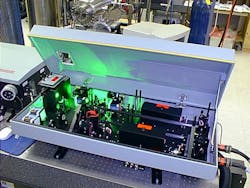Army surveys industry for companies able to provide Nd: YAG laser for etching and semiconductors manufacture
ADELPHI, Md. – U.S. Army researchers are surveying industry for companies able to provide a pulsed neodymium yttrium aluminum garnet (Nd: YAG) laser for cutting and welding steel, semiconductors, and various alloys.
Officials of the Army Contracting Command-Aberdeen Proving Ground in Adelphi, Md., issued a sources-sought notice (W911QX-24-Q-0102) on Thursday for the Nd: YAG laser project. The Army wants quick-turnaround responses by this week.
Nd:YAG lasers are used in manufacturing for engraving, etching, or marking a variety of metals and plastics, or for metal surface enhancement processes like laser peening.
Related: Chasing the goal of an efficient battlefield laser
Researchers specifically are interested in an Nd: YAG laser with:
-- at least eight 825 millijoules of energy per laser pulse;
-- laser pulse width between five to 15 nanoseconds;
-- laser wavelength of 1,064 nanometers;
-- pulse repetition rate of 10 Hz;
-- beam diameter between seven to 12 millimeters;
-- beam divergence less than 0.5 milliradians;
-- a pulse-to-pulse energy stability of 2 percent;
-- power supply with 100 to 240 volts AC at 50/60 Hz, single phase, and 1100 volt-amperes;
-- a cooling unit with an air to water heat exchanger that operates between 18 to 28 degrees Celsius;
-- air to water heat exchanger; and
-- quick installation kit.
Related: Laser weapons: moving from promise to performance
Companies interested should email responses no later than Friday 12 April 2024 to the Army's Andrew Merdoc at [email protected].
Email questions or concerns to Andrew Merdoc at [email protected]. More information is online at https://sam.gov/opp/642b6d01d34e4139bef3f06ddd1a1a2f/view.
About the Author
John Keller
Editor-in-Chief
John Keller is the Editor-in-Chief, Military & Aerospace Electronics Magazine--provides extensive coverage and analysis of enabling electronics and optoelectronic technologies in military, space and commercial aviation applications. John has been a member of the Military & Aerospace Electronics staff since 1989 and chief editor since 1995.
